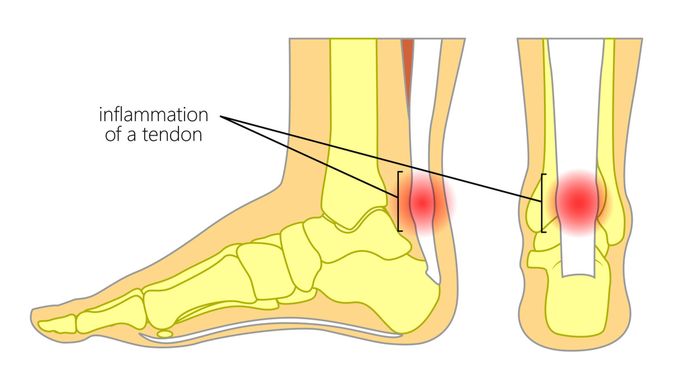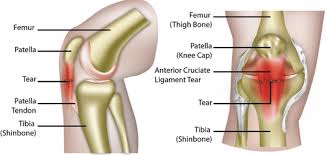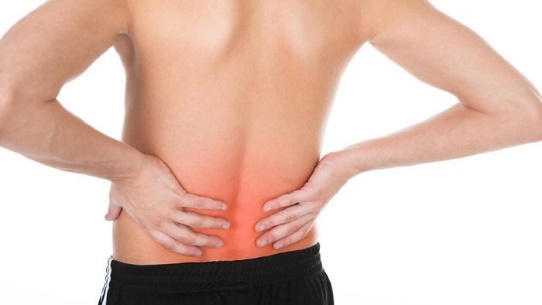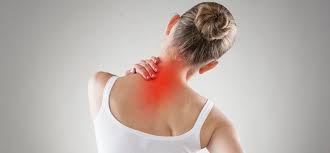
Cycling is a recreational activity or sport , apart from that cycling is also a mode of land transportation that uses bicycles . Bicycles were first introduced in the 19th century AD. Many cycling enthusiasts carry out these activities in various types of terrain, for example: straight paved terrain, hills, steep terrain or just in rural and urban areas. However, cycling can also cause potential injury to cyclists, if you are not careful while cycling. Some of the potential injuries while cycling are as follows:
1. INJURY TO THE ACHILLES ANKLE TENDON
Injury to the achilles tendon when cycling often occurs in cyclists who are too strong to pedal a bicycle. This also often happens to cyclists who don't warm up before cycling. Injury to the Achilles tendon has the potential to take a long time to heal and when used for walking it will feel pain and in some cases swelling in the Achilles tendon.

*Image of Injury to the Achilles Tendon
The things that can be done to avoid potential injury to the Achilles tendon while cycling are as follows:
- Do not make bicycle settings and pedal positions and bicycle saddles too high, make sure the position is ergonomic, not too high and not too low when standing and when pedaling a bicycle.
- Do not pedal too much / too hard, because there is the potential for inflammation of the Achilles tendon.
- Warm up the Achilles tendon before cycling by tiptoeing (hold for 10 to 20 seconds), this can be repeated 10 to 15 times.
- Cooling down by straightening the legs in a sitting position after cycling.
2. PATELLA TENDON INJURY (TENDON OF THE KNEECAPE)
Injury to the patella tendon while cycling can also occur in cyclists who are too strong to pedal a bicycle using large bicycle gears. In addition, a saddle position that is too low also has the potential to cause injury to the patella tendon. This also often happens to cyclists who don't warm up before cycling.

*Image of Injury to the Patellar Tendon
The things that can be done to avoid potential injury to the patella tendon while cycling are as follows:
- Do not make bicycle settings and pedal positions and bicycle saddles too high, make sure the position is ergonomic, not too high and not too low when standing and when pedaling a bicycle.
- Do not pedal too hard/too much and avoid using large bicycle gears for a long time, because there is the potential for inflammation of the patellar tendon.
- Warm up the patella tendon by bending and straightening the knee joint while standing for 10 seconds which can be repeated 10 to 15 times before cycling.
- Cooling down by straightening the knees in a sitting position after cycling.
3. LOWER BACK PAIN
This lower back pain has the potential to occur in cyclists who when cycling bend too much in their body position, so that the body's weight will tend to fall forward and will be followed by muscle and lumbar pull which can cause pain if it occurs for a long time.

*Image of Lower Back Pain
The things that can be done to avoid potential injuries to the lower back while cycling are as follows:
- Ergonomic cycling position settings and the duration of cycling in an aggressive position will cause excessive bending of the muscles and bones of the waist (lumbar region). This is what has the potential to cause low back pain.
- Strengthening the muscles of the lower back should be a focus for cyclists who really like cycling, especially athletes who do long distance cycling.
4. NECK PAIN
Pain in the neck during or after cycling can also occur in cyclists who for a long time keep their head in an extended position while cycling, because in this position the neck will hold the weight of the head for too long, resulting in a potential for neck muscle stiffness (spasm). will cause pain in the neck. In addition, bicycle settings that are not ergonomic can also cause shoulder muscles to feel tense and stiff, causing pain in the neck and shoulders.

*Image of Neck Pain
The things that can be done to avoid the potential for pain in the neck while cycling are as follows:
- Ergonomic cycling position settings that create the right handlebar position, so that the hands and shoulders are not too far apart (too straight).
- When cycling foresight, so as to avoid the position of the head looking up for too long which has the potential to cause pain in the neck.
5. HAND INJURIES
The potential for injury while cycling is an injury to the hand. This can happen if the cyclist holds the bicycle handlebar too tightly, the position of the wrist is too bent and the blisters on the hands are caused by holding the bicycle handlebar too tightly.
The things that can be done to avoid potential hand injuries while cycling are as follows:
- Ergonomic cycling position settings that make the position of the handlebar grip soft (soft) and the height of the handlebar that fits the body position, so that the wrist does not bend up or down (but the wrist is straight).
- Use cyclist gloves to avoid abrasions on the hands.
6. SEXUAL Dysfunction
The final injury that can occur while cycling is sexual dysfunction. This can happen because the cycling time is too long using a hard bicycle saddle and frequent shocks when cycling, causing pressure on the perineum (the area between the anus and the penis / vagina). This will result in the nerves and arteries leading to the penis unable to drain properly, so it has the potential to cause numbness in the genital organs which can cause sexual dysfunction.
The things that can be done to avoid potential sexual dysfunction while cycling are as follows:
- Use a bicycle saddle with soft bearings.
- Looking for a straight, not bumpy track.
- Cycling is not too long, this can be overcome by resting for 15-30 minutes after 45-60 minutes of cycling, so that the flow of blood circulation in the vital organs is flowing properly.
USE OF A MASK WHEN CYCLING
Cycling is a type of exercise that has a mild to moderate intensity and tends to be done in the open. However, during the Covid 19 pandemic, it is necessary to wear a good and correct mask, namely a mask that has good mask pores, so that good air exchange can occur when cycling, in order to prevent the transmission of Covid 19. In addition, maintain a distance and avoid crowds especially when cycling and after cycling it is also necessary to pay attention when cycling with the cyclist community, in order to break the chain of transmission of covid 19. Apart from that, one thing that is no less important is washing hands using soap or hand sanitizer to break the transmission of covid 19.
Thus the discussion of the article regarding the potential for injury when cycling, hopefully this is useful. Don't be tired to exercise. Greetings healthy and fit. Greetings sports.
If you have complaints about injuries while cycling, immediately consult the Team Doctor Sport Clinic at EMC Sentul Hospital.
Article written by dr. Andi Nusawarta, Sp.OT(K)Sport (Sports Injury and Arthroscopy Consultant at EMC Sentul Hospital).
